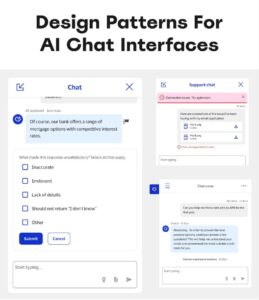Design Patterns For AI Chat Interfaces. With practical guidelines on how to designing more useful, and less annoying AI chat ↓
🚫 Nothing erodes trust more than disguised AI.
🤔 Often users dismiss AI chats almost instinctively.
✅ Users expect an option to “speak to human”.
✅ Be transparent about who users speak to.
✅ Wait for users to end a chat on their terms.
✅ Use separate avatars for AI bot and humans.
✅ Context changes over time: collapse older chats.
✅ Support pinning chats + highlight useful bits.
✅ Let users adjust granularity of reasoning traces.
✅ Allow users to restore iterations of canvases.
✅ Allow users to collapse chat without ending it.
✅ For long, complex tasks → full page screen.
✅ For multi-tasking, co-creation → side panel.
✅ For short, momentary tasks → chat widget.
✅ On mobile, full page AI chat works best.
As many product teams race to not fall behind AI features in their products, we see AI chat interfaces becoming almost second nature every time AI initiative is launched. However, people have difficulty articulating intent in a chat, and good old UI controls — buttons, presets, radio buttons could help there.
Nothing erodes trust more than an AI that desperately pretend to be a human. We might not be able to distinguish AI-generated content from human-crafted content, but human conversations differ significantly from AI chats — and there people spot the difference almost immediately:
– People talk in quick bursts of text → AI is verbose (by default).
– People can respond with 1–2 words → AI respond with sentences.
– People never receive unfinished text → AI “streams” output live.
– Messages can arrive unprompted → AI responds to prompts.
– People have strong opinions → AI is apologetic, overcorrects itself
Knowing that AI is on the other side isn’t really a problem — it’s what is required to build trust. And when people realize they talk to a chatbot, they are more direct, use “keyword” language, and avoid politeness markers. But when service does provide access to humans, it shows that company cares about customers.
Human answer might not be accurate or swift, but it builds a much stronger relationship with the brand, especially when things go unexpected ways.
💎 Useful resources:
Visa Design System: Chat UI Patterns
https://lnkd.in/ewVjfr86
The Quest For Usable AI, by Michael Gower
https://lnkd.in/eeq83btK
Usable Chat Interfaces to AI Models, by Luke Wroblewski
https://lnkd.in/d-Ssb5G7
UX Guidelines For Chat UX, by Raluca Budiu
https://lnkd.in/e7-RErGE
#ux #design
Design Patterns for AI Chat Interfaces
